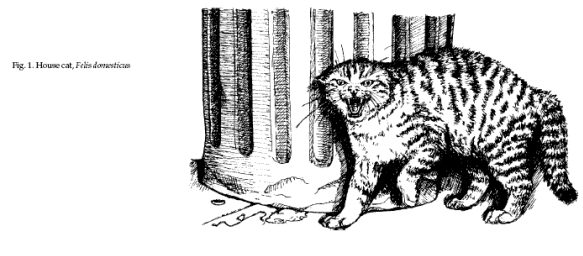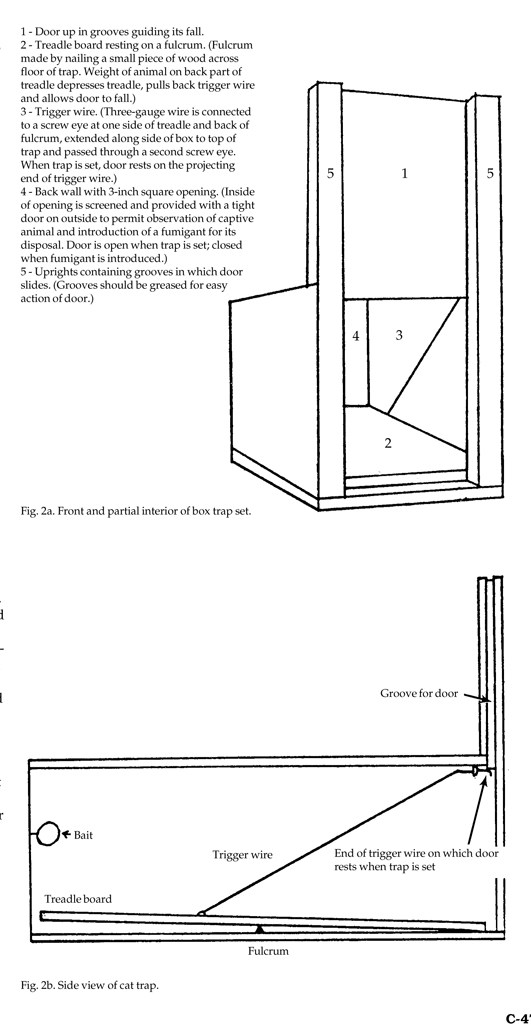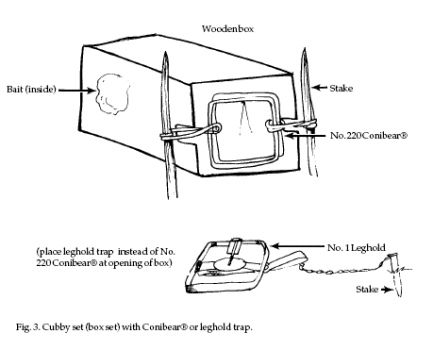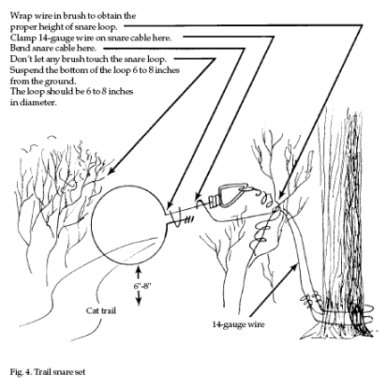|
|
|
|
 |
CARNIVORES: House Cats (Feral) |
|
|

Fig. 1. House cat, Felis
domesticus
Identification
The cat has been the most
resistant to change of all the animals that humans have
domesticated. All members of the cat family, wild or
domesticated, have a broad, stubby skull, similar facial
characteristics, lithe, stealthy movements, retractable
claws (except the cheetah), and nocturnal habits.
Feral cats (Fig. 1) are
house cats living in the wild. They are small in
stature, weighing from 3 to 8 pounds (1.4 to 3.6 kg),
standing 8 to 12 inches (20 to 30.5 cm) high at the
shoulder, and 14 to 24 inches (35.5 to 61 cm) long. The
tail adds another 8 to 12 inches (20 to 30.5 cm) to
their length. Colors range from black to white to
orange, and an amazing variety of combinations in
between. Other hair characteristics also vary greatly.
Range
Cats are found in
commensal relationships wherever people are found. In
some urban and suburban areas, cat populations equal
human populations. In many suburban and eastern rural
areas, feral house cats are the most abundant predators.
Habitat
Feral cats prefer areas in
and around human habitation. They use abandoned
buildings, barns, haystacks, post piles, junked cars,
brush piles, weedy areas, culverts, and other places
that provide cover and protection.
Food Habits
Feral cats are
opportunistic predators and scavengers that feed on
rodents, rabbits, shrews, moles, birds, insects,
reptiles, amphibians, fish, carrion, garbage,
vegetation, and leftover pet food.
General Biology, Reproduction, and Behavior
Feral cats produce 2 to 10
kittens during any month of the year. An adult female
may produce 3 litters per year where food and habitat
are sufficient. Cats may be active during the day but
typically are more active during twilight or night.
House cats live up to 27 years. Feral cats, however,
probably average only 3 to 5 years. They are territorial
and move within a home range of roughly 1.5 square miles
(4 km2). After several generations, feral cats can be
considered to be totally wild in habits and temperament.
Damage Feral cats feed
extensively on songbirds, game birds, mice and other
rodents, rabbits, and other wildlife. In doing so, they
lower the carrying capacity of an area for native
predators such as foxes, raccoons, coyotes, bobcats,
weasels, and other animals that compete for the same
food base.
Where documented, their
impact on wildlife populations in suburban and rural
areas—directly by predation and indirectly by
competition for food— appears enormous. A study under
way at the University of Wisconsin (Coleman and Temple
1989) may provide some indication of the extent of their
impact in the United States as compared to that in the
United Kingdom, where Britain’s five million house cats
may take an annual toll of some 70 million animals and
birds (Churcher and Lawton 1987). Feral cats
occasionally kill poultry and injure house cats.
Feral cats serve as a
reservoir for human and wildlife diseases, including cat
scratch fever, distemper, histoplasmosis, leptospirosis,
mumps, plague, rabies, ringworm, salmonellosis,
toxoplasmosis, tularemia, and various endo- and
ectoparasites.
Legal Status
Cats are considered
personal property if ownership can be established
through collars, registration tags, tattoos, brands, or
legal description and proof of ownership. Cats without
identification are considered feral and are rarely
protected under state law. They become the property of
the landowner upon whose land they exist. Municipal and
county animal control agencies, humane animal shelters,
and various other public and private “pet” management
agencies exist because of feral or unwanted house cats
and dogs. These agencies destroy millions of stray cats
annually.
State, county, and
municipal laws related to cats vary. Before lethal
control is undertaken, consult local laws. If live
capture is desired, consult the local animal control
agency for instructions on disposal of cats.
Damage
Prevention and Control Methods Exclusion
Exclusion by
fencing, repairing windows, doors, and plugging holes in
buildings is often a practical way of eliminating cat
predation and nuisance. Provide overhead fencing to keep
cats out of bird or poultry pens. Wire mesh with
openings smaller than 2.5 inches (6.4 cm) should offer
adequate protection.
Cultural Methods
Cat numbers can be reduced
by eliminating their habitat. Old buildings should be
sealed and holes under foundations plugged. Remove brush
and piles of debris, bale piles, old machinery, and
junked cars. Mow vegetation in the vicinity of
buildings. Elimination of small rodents and other
foodstuffs will reduce feral cat numbers.
Repellents
The Environmental
Protection Agency (EPA) has registered the following
chemicals individually and in combination for repelling
house cats: anise oil, methyl nonyl ketone, Ro-pel, and
Thymol. There is little objective evidence, however, of
these chemicals’ effectiveness. Some labels carry the
instructions that when used indoors, “disciplinary
action” must reinforce the repellent effect. Some
repellents carry warnings about fabric damage and
possible phytotoxicity. When used outdoors, repellents
must be reapplied frequently. Outdoor repellents can be
used around flower boxes, furniture, bushes, trees, and
other areas where cats are not welcomed. Pet stores and
garden supply shops carry, or can order, such
repellents. The repellents are often irritating and
repulsive to humans as well as cats.
Frightening
Dogs that show aggression
to cats provide an effective deterrent when placed in
fenced yards and buildings where cats are not welcome.
Toxicants
No toxicants are
registered for control of feral cats.
Fumigants
No fumigants are
registered for control of feral house cats. Live-trapped
cats or cats in holes or culverts can be euthanized with
carbon dioxide gas or pulverized dry ice (carbon
dioxide) at roughly 1/2 pound per cubic yard (0.3 kg/m3)
of space.
Trapping
 Live
Traps. Live-trapping cats in commercial or
homemade box traps (Fig. 2) is a feasible control
alternative, particularly in areas where uncontrolled
pets are more of a problem than wild cats. Trap openings
should be 11 to 12 inches (28 to 30 cm) square and 30
inches (75 cm) or more long. Double-ended traps should
be at least 42 inches (105 cm) long. The cat can be
captured and turned over to animal control agencies
without harm, given back to the owner with proper
warnings, or euthanized by shooting, lethal injection,
or asphyxiation with carbon dioxide gas. Sources for
commercial traps are found in Supplies and Materials.
Set live traps in areas of feral cat activity, such as
feeding and loafing areas, travelways along fences, tree
lines, or creeks, dumps, and garbage cans. Successful
baits include fresh or canned fish, commercial cat
foods, fresh liver, and chicken or rodent carcasses.
Catnip and rhodium oil are often effective in attracting
cats. Live
Traps. Live-trapping cats in commercial or
homemade box traps (Fig. 2) is a feasible control
alternative, particularly in areas where uncontrolled
pets are more of a problem than wild cats. Trap openings
should be 11 to 12 inches (28 to 30 cm) square and 30
inches (75 cm) or more long. Double-ended traps should
be at least 42 inches (105 cm) long. The cat can be
captured and turned over to animal control agencies
without harm, given back to the owner with proper
warnings, or euthanized by shooting, lethal injection,
or asphyxiation with carbon dioxide gas. Sources for
commercial traps are found in Supplies and Materials.
Set live traps in areas of feral cat activity, such as
feeding and loafing areas, travelways along fences, tree
lines, or creeks, dumps, and garbage cans. Successful
baits include fresh or canned fish, commercial cat
foods, fresh liver, and chicken or rodent carcasses.
Catnip and rhodium oil are often effective in attracting
cats.
Leghold Traps.
Leghold traps No. 1, 1.5, or 2 are sufficient to catch
and hold feral cats (Fig. 3). These traps are
particularly useful on cats that are not susceptible to
box traps. Place the traps in a shallow hole the size
and shape of the set trap. Cover the pan with waxed
paper and then cover the trap with sifted soil, sawdust,
or potting soil. Place the bait material far enough
beyond the trap that the cat must step on the trap to
reach it. Traps can be set at entrances to holes where
cats are hiding, entryways to buildings, or near garbage
cans. Domestic cats caught in leghold traps should be
handled with care. Cover the cat with a blanket, sack,
or coat; pin it down with body weight; and release the
trap. Catch poles can also be used to subdue trapped
cats.
Conibear® or Body-gripping
Traps. Conibear® or body-gripping traps are lethal traps
that work like double-jawed mouse traps. They should be
set only where no other animals will get into them. The
No. 220 size is most effective for cats. Set traps in
front of culverts or entry holes, in garbage cans, or
boxes with the bait placed in the back (Fig. 3).


Snares.
Snare sizes No. 1 and 2 are very effective as live traps
or kill traps when set properly. Place snares in
entrances to dens or crawlthroughs, in trails in weeds,
or in garbage cans, boxes, or other restricted access
arrangements where bait is placed (Fig. 4). Sources for
snares are found in Supplies and Materials.
Shooting
Feral cats can be shot
with .22 rimfire and other calibers of centerfire rifles
and shotguns in rural areas where it is safe. In
buildings and urban areas, powerful air rifles are
capable of killing cats with close-range head shots.
Cats can be lured out of heavy cover for a safe shot by
using predator calls, elevated decoys of fur or
feathers, or meat baits.
Other Methods
Supplemental feeding of
feral or free-roaming house cats will probably have
little effect in reducing their depredations on
songbirds and other wildlife. Even well-fed cats will
often bring home a small prey they have caught and
proudly display it to their owners without eating it.
Laboratory studies suggest that hunger and hunting are
controlled by separate neurological centers in the cat
brain, so the rate of predation is not affected by the
availability of cat food.
The hunter is often the
hunted. Dogs and coyotes, which are adapting to urban
environments, are probably the greatest predators of
cats, next to humans and cars. Feral cats are often
found on the borders of human habitation. Large
predators such as bobcats, mountain lions, fox, coyotes,
and feral dogs eliminate cats that stray too far a field
In the final analysis,
many problems with feral cats could be avoided if cat
owners would practice responsible pet ownership. The
same licensing and leash laws pertaining to dogs should
be applied to cats. Spaying or neutering should be
encouraged for household pets not kept for breeding
purposes. Neutering is not a cost-effective program for
controlling feral populations. Unwanted cats should be
humanely destroyed, not abandoned to fend for
themselves.
Economics of Damage and Control
The place of cats in the
modern urban world is certainly secure even though their
reputation as rodent controllers has not been supported
by objective research. Cats have replaced dogs as the
most common family pet in the United States. Their
owners support a growing segment of the economy in the
pet food and pet supplies industries. On the other hand,
feral cats are responsible for the transmission of many
human and wildlife diseases and kill substantial amounts
of wildlife.
Acknowledgments
I wish to acknowledge M.
L. Boddicker, who was the author of the “House Cats”
chapter in the 1983 edition of Prevention and Control of
Wildlife Damage.
Figure 1 by Emily Oseas
Routman.
Figure 2 adapted from
Boddicker (1978), “Housecats” in F. R. Henderson,
Prevention and Control of Wildlife Damage, Kansas State
Univ., Manhattan.
Figure 3 by M. L.
Boddicker, adapted by Jill Sack Johnson.
Figure 4 courtesy of
Gregerson Manufacturing Co., adapted by Jill Sack
Johnson.
For Additional Information
Anonymous. 1974. Ecology of the surplus dog and cat
problem. Proc. Natl. Conf. Am. Humane Assoc., Denver,
Colorado. 128pp.
Bisseru, B. 1967. Diseases
of man acquired from his pets. Wm. Heinermann Medical
Books, London. 482 pp.
Boddicker, M. L. 1979.
Controlling feral and nuisance house cats. Colorado
State Univ. Ext. Serv., S.A. Sheet No. 6.508, Ft.
Collins.
Churcher, P. B., and J. H.
Lawton. 1987. Predation by domestic cats in an English
village. J. Zool. (London) 212:439-455.
Coleman, J. S., and S. A.
Temple. 1989. Effects of free-ranging cats on wildlife:
a progress report. Proc. Eastern Wildl. Damage Control
Conf. 4:9-12.
Coman, B. J., and H.
Brunner. 1972. Food habits of the feral house cat in
Victoria. J. Wildl. Manage. 36:848-853.
Errington, P. L. 1936.
Notes on food habits of southern Wisconsin house cats.
J. Mammal. 17:64-65.
Fitzwater, W. D. 1986.
Extreme care needed when controlling cats. Pest Control
54:10.
Jackson, W. B. 1951. Food
habits of Baltimore, Maryland cats in relation to rat
populations. J. Mammal. 32:458-461.
Parmalee, P. W. 1953. Food
habits of the feral house cat in east-central Texas. J.
Wildl. Manage. 17:375-376.
Remfry, J. 1985. Humane
control of feral cats. Pages 41-49 in D. P. Britt, ed.
Humane control of land mammals/birds. Univ. Fed. An.
Welfare. United Kingdom.
Rolls, E. C. 1969. They
all ran wild: the story of pests on the land in
Australia. Angus and Robertson, Sydney and London.
444pp.
Tuttle, J. L. 1978. Dogs
and cats need responsible owners. Univ. Illinois Coop.
Ext. Serv. Circ. No. 1149.
Warner, R. E. 1985.
Demography and movements of free-ranging domestic cats
in rural Illinois. J. Wildl. Manage. 49:340-346.
Webb, C. H. 1965. Pets,
parasites, and pediatrics. Pediatrics 36:521-522.
Editors
Scott E. Hygnstrom Robert
M. Timm Gary E. Larson
PREVENTION AND CONTROL OF
WILDLIFE DAMAGE — 1994
Cooperative Extension
Division Institute of Agriculture and Natural Resources
University of Nebraska -Lincoln
United States Department
of Agriculture Animal and Plant Health Inspection
Service Animal Damage Control
Great Plains Agricultural
Council Wildlife Committee
01/23/2007
Special
thanks to:
Clemson University
|